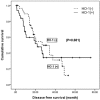Can heme oxygenase-1 be a prognostic factor in patients with hepatocellular carcinoma?
- PMID: 31261522
- PMCID: PMC6617477
- DOI: 10.1097/MD.0000000000016084
Can heme oxygenase-1 be a prognostic factor in patients with hepatocellular carcinoma?
Abstract
Heme oxygenase-1 (HO-1) is an important catalytic enzyme in heme degradation, which increases during stressful conditions. It plays a major role in antioxidative and antiapoptotic processes and is associated with tumor growth and metastasis.This study aimed to evaluate the degree of HO-1 expressions in hepatocellular carcinoma (HCC) surgical specimens and the correlation between HO-1 expression and patient prognosis. Formalin-fixed, paraffin-embedded HCC tissue samples (n = 96) were included in the analysis, and the expression of HO-1 was evaluated by immunohistochemical staining. We reviewed clinical features of patients and evaluated the prognostic role of HO-1 in patient survival and recurrence.Positive HO-1 expression was identified in 43 cases (44.8%) and was frequently found in patients with advanced histology (Edmondson-Steiner [E-S] grade 2, 3, 4), α-fetoprotein (AFP) level of more than 200 IU/mL, and the presence of microvascular and capsular invasion (P < .05). In the univariate analysis, the overall survival (OS) and disease-free survival (DFS) of patients with HO-1-positive HCC were not statistically different from those with HO-1-negative HCC. Moreover, HO-1 expression was not associated with patient survival and recurrence based on the multivariate analysis. In the subgroup analysis of patients without preoperative transarterial chemoembolization (TACE) (n = 61), HO-1 was not also associated with tumor recurrence (P = .681).The clinical implication of HO-1 activity is controversial in various malignancies. However, HO-1 expression did not seem to influence the prognosis of HCC patients.
Conflict of interest statement
There is no potential conflict of interest relevant to this article.
Figures




References
-
- Imamura H, Matsuyama Y, Tanaka E, et al. Risk factors contributing to early and late phase intrahepatic recurrence of hepatocellular carcinoma after hepatectomy. J Hepatol 2003;38:200–7. - PubMed
-
- Schoemaker MH, Ros JE, Homan M, et al. Cytokine regulation of pro- and anti-apoptotic genes in rat hepatocytes: NF-kappaB-regulated inhibitor of apoptosis protein 2 (cIAP2) prevents apoptosis. J Hepatol 2002;36:742–50. - PubMed
-
- Yamaguchi Y, Shiraki K, Fuke H, et al. Targeting of X-linked inhibitor of apoptosis protein or survivin by short interfering RNAs sensitize hepatoma cells to TNF-related apoptosis-inducing ligand- and chemotherapeutic agent-induced cell death. Oncol Rep 2005;14:1311–6. - PubMed
-
- Sass G, Leukel P, Schmitz V, et al. Inhibition of heme oxygenase 1 expression by small interfering RNA decreases orthotopic tumor growth in livers of mice. Int J Cancer 2008;123:1269–77. - PubMed
MeSH terms
Substances
LinkOut - more resources
Full Text Sources
Medical
Miscellaneous

